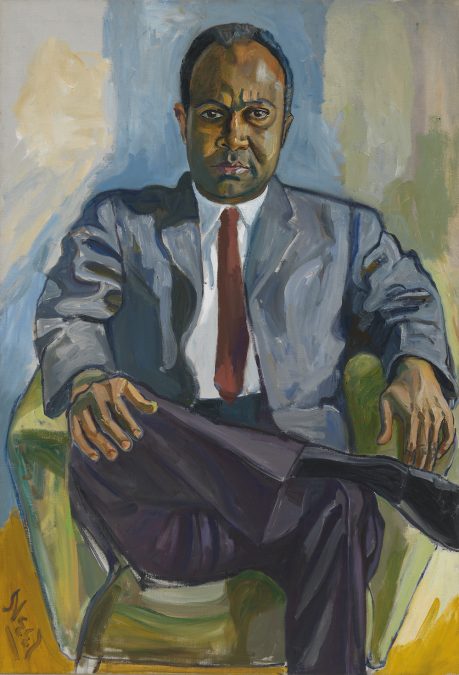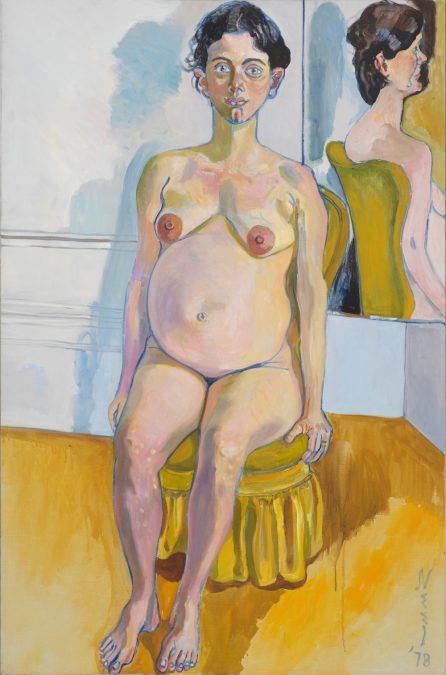Alice Neel, Painter of the People
Portraiture was a bourgeois concept to the late American painter Alice Neel. She preferred to describe her work as “pictures of people.” These pictures, painted in her signature style of detailed figuration with abstract flourishes, evade the kinds of commercial appeal that made portraits so marketable to the rich. Her oeuvre did not shamelessly flatter the wealthy — it was an archive of the everyday people in her life.
For all the celebrities and political figures she painted, Neel portrayed them as they would appear to the common viewer. She practiced a kind of radical humanism in her art, but her commitments to American socialism have long been buried under her contributions to expressionism more generally. The Metropolitan Museum of Art’s new Neel retrospective, People Come First, recontextualizes her career as a people’s painter.
The first comprehensive Neel exhibition in twenty years, People Come First frames her politics through personal experiences — her intimate relationships with people who made history and others who drifted from historical memory. Her subjects ranged from community organizers, civil rights activists, Communist Party leaders, neighbors in Spanish Harlem, and queer artists and performers. Throughout her career, Neel brought underrepresented and oppressed people into the spotlight.
Neel once described herself as a “collector of souls” in the spirit of Russian playwright Anton Chekhov, who was widely known for his ability to convey the human condition through his characters. In keeping with her Marxist views, she considered art intrinsically linked to economic and cultural conditions. Her body of work, in turn, functions as a documentary of the significant political issues of her lifetime. The appearance of art world giants, revolutionary socialists, lovers, family members, and strangers together breaks down social divisions and levels their status within the Met gallery, as each is unmistakably painted by Alice Neel.
Born in 1900 and raised in a Pennsylvania suburb, Neel started painting at the Philadelphia School of Design for Women (now Moore College of Art & Design) in the early 1920s. After graduating, she moved to Havana, Cuba with her husband Carlos Enríquez, who was an artist in the Cuban avant-garde, or vanguardia. Together, they painted pedestrians and observed social inequalities in the prerevolution era.

Enríquez introduced Neel to prominent Cuban intellectuals like novelist Alejo Carpentier and painter Marcelo Pogolotti, as well as painterly theory texts like Robert Henri’s The Art Spirit and José Ortega y Gasset’s “The Dehumanization of Art” (1925) — the latter of which argued against the perceived lifelessness of modernist abstraction. Her paintings of Cuban pedestrians, the earliest in the exhibition, embody these influences with broad, expressive brushstrokes in muted earth tones.
After losing their first child to diphtheria, Neel and Enríquez returned to the United States where they had their second child, Isabetta. Soon after, Enríquez abandoned Neel and returned to Cuba with Isabetta, sending Neel into a nervous breakdown. After a suicide attempt and hospitalization, she took to painting scenes of anguish in overcrowded hospitals, exemplified in Well Baby Clinic and Suicidal Ward, Philadelphia General Hospital. Rough, jagged line work distorts the faces and bodies of patients and doctors alike.
After her recovery, Neel moved to New York City to make a living during the Great Depression. Many American artists, writers, and performers joined radical political organizations during this time, and Neel was no different. While residing on Cornelia Street in Greenwich Village, she joined the Communist Party USA, attended meetings of the Artists’ Union and the John Reed Club (a Marxist-Leninist organization associated with the Communist Party and New Masses magazine), and contributed artworks to socialist publications like Masses & Mainstream and Art Front — all of which were a short walk from her apartment.
Along with artists like Ben Shahn and Jacob Lawrence, Neel was employed by the Public Works of Art Program (PWAP) and Works Progress Administration (WPA). Her paintings from this time reflect daily struggles of life on the precipice of war and financial ruin.
Nazis Murder Jews portrays a May Day protest she attended, with other WPA artists, against the spread of fascism in Europe. Communist Party members march down a wide avenue carrying red flags with the yellow hammer and sickle.

In another WPA painting, Investigation of Poverty at the Russell Sage Foundation, a homeless mother of seven holds her head in her hands, dressed in black and surrounded by indifferent observers. Neel was highly critical of the Russell Sage Foundation, a nonprofit organization founded to improve social and living conditions in the United States, which, she once claimed, “never gave a penny to the poor, but they investigated the poor.”

Portraits from this era largely adhered to conventional realism, while others are more surreal and fantastical. Baltimore union leader Pat Whalen clenches his fists over the June 16, 1935 issue of the Daily Worker, with a headline reporting steel and coal worker strikes that he helped organize. Kenneth Fearing, the first poetry editor of the Marxist publication Partisan Review, appears at a desk with an open book. Around him, a miniature cityscape unfolds: pedestrians, traffic, an outdoor wedding, a police beating. A small skeleton pours blood from a gap in Fearing’s chest, reflecting Neel’s sentiment that his “heart bled for the grief of the world.”

Painting from experience allowed Neel to address broader political concerns in her art. Futility of Effort, which shows a disfigured infant in a crib, originated from her memories of losing a child and a similar story she read in the news.
The painting appeared in a 1938 exhibition at ACA Galleries and in an issue of Art Front under the name Poverty, allowing Neel to push women’s health issues to the forefront of prominent art spaces. In this way, she committed to painting as a means of education and social uplift, which would continue after moving uptown in Manhattan.
In the late 1930s, Neel and then partner José Santiago Negrón moved to Spanish Harlem, a predominantly Puerto Rican neighborhood where she lived for more than twenty years. This was at a time when many Cuban and Dominican immigrants were moving there as well, and Neel was appalled at the kinds of racism and financial precarity they faced. Some of the people she painted were influential activists, others friends, family, and neighbors.
A portrait of Negrón shows the nightclub singer holding a guitar with sheet music for the song “Puerto Rico Libre!” — referencing its colonial status in the United States. Negrón left Neel after the birth of their child, but Neel stayed connected with his family and painted them under anonymous titles (such as The Spanish Family, showing the wife and children of Negrón’s brother).

In T.B. Harlem, she portrayed Negrón’s brother Carlos, bedridden with tuberculosis — a disease that disproportionately affected (and still affects) poor communities of color. Carlos rests his hand on a bandage over his heart, his gleaming eyes fixed on the viewer.

Community organizer Mercedes Arroyo gazes upward, seemingly lost in thought. Arroyo taught at the Communist Party–affiliated Jefferson School of Social Science and helped establish an art school for children on the east side. Radical playwright Alice Childress, the first black woman to produce a professional play in the United States, appears in a crimped blue dress beside a vase of yellow flowers. Childress frequented some of the same Marxist organizations as Neel and had recently published her play Florence in Masses & Mainstream. Within a few years, Childress became a target of FBI surveillance with other black radicals like Paul Robeson and Lorraine Hansberry.

After moving to the Upper West Side, Neel continued to paint left-leaning artists and activists like Robert Smithson, Benny Andrews, and James Farmer — the cofounder of CORE (Congress of Racial Equality) who had recently been arrested for organizing a massive protest at the World’s Fair in Queens. This was also when Neel broke into the mainstream art world, at the height of an emerging women’s rights movement.

Neel’s work began to be widely shown at renowned New York galleries from the late 1960s onward, leading her to paint high-profile men in the art world like curator Henry Geldzahler and LIFE magazine editor David Bourdon. She also started painting pregnant women in the nude.
Far from idealized, Neel’s expecting mothers are casual and nonchalant — fitting for her description of pregnancy as “just a fact of life.” Neel had by that time raised two children, Richard and Hartley from leftist filmmaker Sam Brody, all on her own. She rejected the notion that pregnancy implied submission to the patriarchy and embraced the effects of childbearing on women’s bodies.
These paintings, as well as nude domestic scenes with lovers, show Neel claiming the erotic for her own — a realm previously reserved for cisgendered, heterosexual male painters. A portrait of critic John Perreault, sprawled on a couch completely naked, bears similarity to the Cosmopolitan centerfold of Burt Reynolds from the same year, which helped publicize women’s erotica. Art critic Cindy Nemser, who died in January this year, appears in a shy nude portrait with her husband Chuck. A lifelong champion of Neel’s work, Nemser featured Neel’s art in the first issue of the feminist journal Women and Art in 1971. Many of Neel’s nude paintings were created during the era of the Hays Code, a conservative crackdown on American art, and did not appear publicly for more than a decade.

Neel may not have aligned fully with second-wave feminism, perhaps due to her roots in the Old Left. But she painted radical feminist intellectuals like Irene Peslikis, Adrienne Rich, and Faith Ringgold, and gender-nonconforming Warhol superstar Jackie Curtis both in and out of drag. She believed in uplifting women’s agency within broader working-class struggle — what Met curator Kelly Baum describes as “scandalous red feminism.”

In a statement for her 1973 solo exhibition at David Zwirner Gallery, Neel wrote, “The enemy perhaps is not men but the very system itself which also encourages men to oppress each other.” That system was unquestionably capitalism.
In a 1950 Daily Worker interview with Jewish writer Mike Gold, Neel once said, “There isn’t much good portrait painting being done today, and I think it is because with all this war, commercialism and fascism, human beings have been steadily marked down in value, despised, rejected and degraded.” That same year, she painted a rally she attended to free an unjustly convicted black man in Mississippi, who was later executed. Protesters stand at the base of the Benjamin Franklin Statue outside New York City Hall in Save Willie McGee, with signs that read “Stop Legal Lynching” and “Black and White Unite.”

Within a few months, the FBI would begin its years-long investigation of Neel. From 1951 to 1955, the bureau tracked her involvement in political organizations and protests, describing her as a “romantic Bohemian type communist” and interrogating her for associating with radical thinkers.
Despite wanting to achieve success as an artist, Neel was somewhat allergic to the art industry’s slow progress. She stayed politically active late in life, protesting the lack of black and Latino representation at the Whitney, and joined the Black Emergency Cultural Coalition (BECC) to protest the Met’s controversial Harlem on My Mind exhibition. She also contributed protest drawings to The Attica Book, published by the BECC in solidarity with the New York prison uprising.
In a 1971 conversation on Andy Warhol, Neel claimed that “people are the greatest and profoundest key to an era.” She had recently chosen to depict the Pop Art icon shirtless with a gunshot wound on his torso, following an assassination attempt by SCUM Manifesto author Valerie Solanas. Perhaps this was Neel’s sense of irony, that a towering figure of contemporary art could be so frail yet remain so striking.

Until her death in 1984, she received criticism for not making big enough sales or attracting heavyweight curators. Hilton Kramer of the New York Times panned her 1974 Whitney exhibition, claiming there were “ineptitudes” in her style that brought her competence into question and arguing that her sitters were “contributing to a minority entertainment.” True enough, she rarely prepared sketches before painting. She drew directly on canvas with a paintbrush, giving her work an unfinished aesthetic that was all her own.
It’s possible that industry experts were unprepared for a socialist who was more concerned with the soul than the scenery. But Neel’s work has endured petty scrutiny for decades. Now, with her retrospective at the Met, her redefinition of how the human condition appears in art can be fully appreciated.


